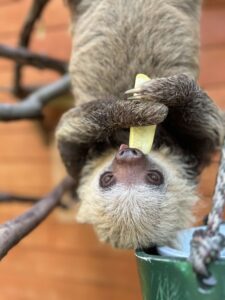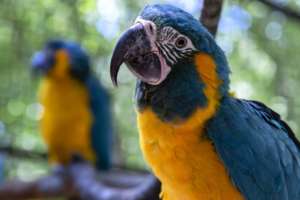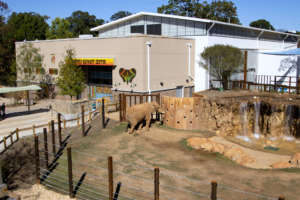Research is an integral part of our mission at Zoo Atlanta.
Research helps us better understand and provide stewardship for the animals in our care, and it provides us with valuable insights that enable us to protect their counterparts in the wild. Our basic research also contributes to our knowledge of life on Earth. The Zoo has a practice of asking questions and seeking answers as part of research studies focused among animal populations, both at the Zoo and in the wild.
With hundreds of animals residing at Zoo Atlanta, ensuring their health and wellbeing is our top priority. From frogs and flamingos to elephants and otters, Zoo Atlanta has a specialized team of animal care professionals, veterinarians, nutritionists, and animal welfare scientists who look after each individual in our care. Animal wellbeing is the combined physical, mental, and emotional state of an animal over a period of time that can be measured in a variety of ways. At Zoo Atlanta, we have a team of animal welfare scientists who partner closely with animal care professionals and make recommendations to provide the best and most dynamic environments for the animals.
Animal welfare scientists utilize the scientific method to propose questions, make a hypothesis, and then set out to answer those questions using data. This important standardized approach helps to answer questions about each of the animals’ wellbeing.
Follow the scientific inquiry process below to learn how animal welfare scientists use data to understand the science of animal behavior, cognition, and emotions, and how they apply what is learned to make decisions for the wellbeing of the animals at Zoo Atlanta.
Nature has a lot to teach us if we just take the time to look. We hope this poster will enhance your curriculum by encouraging your students to look to nature for inspiration. To learn more about research projects at Zoo Atlanta, visit our Research page.
Use the poster to connect to your curriculum! View our past poster designs and curriculums to further your learning in the classroom.
Next Generation Science Standard: 3-LS1-1
Georgia Standard of Excellence: SKL1a, S1L1, S2L1, S3L1, S4L1, S7L1, SZ4.a
Use this year’s Education Poster to learn about an exciting STEM career.



Start by looking at animal images with students. Encourage students to make observations based on the photos. Students will draw a T chart in a science journal or STEM notebook. The left side will list student observations based on the photo. The right side of the T chart should be filled with student questions:
Students create a list of questions on the right side of the chart based on what is unseen or unknown about photos. Prompt students by asking, “What do you think the animal is doing?” Allow students to share observations with a buddy or the group. Point out clues in the pictures that show the physical features of the animal and habitat, as well as provide clues about social dynamics.
Once students have practiced with the class, they can practice observing an animal in their habitat. Encourage students to draw a picture (or take a photo) of the animal and the habitat, observe a few behaviors, and write any special notes or observations. Students can observe animals in the classroom, a birdfeeder, an aquarium, or even on a webcam like Zoo Atlanta’s Gorilla Cam. Students should be able to create questions based on observations.
This activity allows students to observe animal behaviors like an animal welfare scientist. You may notice welfare scientists observing animal behavior when you visit the Zoo. They can be seen inputting data on tablets throughout the day. Behavioral studies have been completed on many individuals, including fossa, elephants, gorillas, giraffes, golden lion tamarin, tawny frogmouths, milky eagle owls, blue-throated macaws, alpacas, and many others.
Students can observe Zoo animals in person on a Self-Guided Field Trip. Plan a field trip to Zoo Atlanta!
NGSS: 2-LS4-1, 3-LS3-1, 3-LS4-3
GSE: S1L1, S5L2a
Students can practice data collection while they observe animal behaviors at school or home.
Simple experiments can be designed in the classroom so students can practice collecting behavioral data. A classroom window with an outdoor view is a great way to spark curiosity. Gather three identical cups and carefully conceal a handful of peanuts (or a tasty birdseed treat) beneath one, leaving the other two cups empty. Show students the three cups and ask which cup they think the squirrels will check first. Place the three cups outside the window where students can watch. Students should observe squirrels multiple times at different times of day to collect many data points and create hypotheses or new questions to test.
Sample table
| Time | First cup overturned | Squirrel notes | Other observations/questions |
| 9:48 a.m. | Left | Same squirrel (missing part of tail) chose the left one yesterday | Are squirrels right or left-handed? |
| 1:09 p.m. | Middle | Unknown squirrel | Nervous squirrel |
In this experiment, the squirrel is like a game show contestant, choosing from three different doors that have unknown prizes behind them. Squirrels volunteer to participate because they are actively using their senses and get rewarded with a treat. Anything that makes an animal’s environment more stimulating is called enrichment. Animal welfare scientists at Zoo Atlanta study how enrichment impacts the wellbeing of animals.
Would you like to observe some animals in your classroom this year? Our ZooMobiles can bring the Zoo to you! For more information and to reserve your program, click here.
NGSS: K-ESS3-3
GSE: S3L2, S4L2, S1L1
Imagine sitting in your kitchen and finding out you were going to live in there. You can’t go outside. With plenty of fresh food and water, a person could survive, but would you be healthy? If the food is healthy, your body might be healthy, but you would probably feel bored and unhappy. Your total health includes physical (body) health, mental (emotional) health, and social health. People and animals need all three to be healthy. Physical health includes nutrition, exercise, and sleep. Mental health includes your emotions and how you manage stress. Social health includes your relationships and how you interact with others. We can think about total health as a balanced triangle.
SEL connection activity: Print or draw an equilateral triangle divided into thirds. Label the three sections physical health, mental health, and social health. Students write or draw a picture of something they do to support each type of health. Students should write an improvement goal for each of the sections.
Zoo welfare scientists ask questions about an animal's physical health, natural behaviors, and how animals are interacting with their environment. You may notice some strange items in certain habitats like bags with hay and branches sticking out, wheels, and wooden boxes that look like puzzles. These are enrichment. Enrichment is anything that makes an animal’s environment more stimulating.

Looking at a picture of part of the elephant habitat at Zoo Atlanta, you may notice a wall that is full of holes. This enrichment wall allows elephants to use the dexterity of their trunks to search for treats hidden in buckets on the other side.
Take a trip to the Zoo, book a Wild Walk program today! Students can observe habitat enrichments in person and find out how they support animal wellbeing.
NGSS: 2-LS4-1, MS-LS2-2, HS-LS2-8
GSE: S1L1, S2L1, S4L1, S5L2
At Zoo Atlanta, an accredited member of the Association of Zoos and Aquariums (AZA), observing and monitoring the health of all animals is taken seriously. “Members of the Association of Zoos and Aquariums (AZA) believe that the wellbeing of the animals in our care is both our moral responsibility and foundational to AZA’s mission. To support this belief, AZA members commit their diverse expertise to continuously advance and share knowledge, tools, and actions that promote the wellbeing of animals. We aspire to be globally trusted leaders in enhancing the wellbeing of animals.” To learn more about animal wellbeing, visit the AZA Animal Wellbeing page here: aza.org/about-animal-wellbeing
Students can explore the STEM career of an animal welfare scientist by researching their own questions utilizing the scientific inquiry process.
